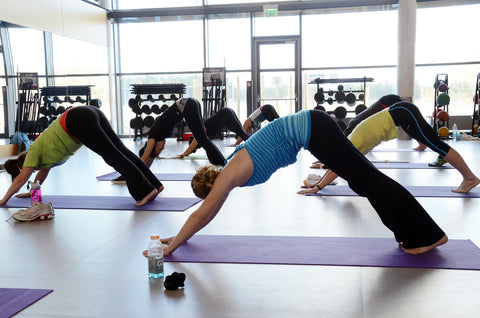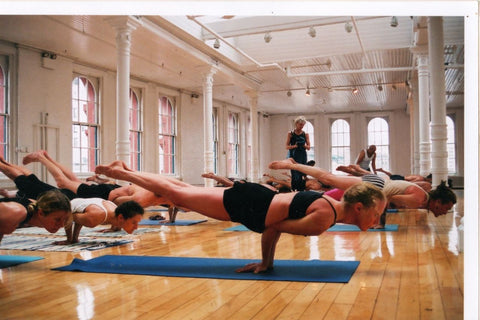
The benefits of exercise can’t be overstated—a regular fitness habit keeps us physically, mentally, and even emotionally healthy. It makes life more enjoyable, and of course, it can keep us living longer, too.
Research has also shown the benefits of exercise can reduce the risk of developing certain types of cancers. It may even be helpful in keeping cancer from coming back. But how that specifically occurs, has never really been clear. A new study may have changed that, though.
Published in the recent issue of the journal Cell Metabolism, new data points to adrenalin levels produced by exercise as the key to thwarting malignant growth.
Researchers at Copenhagen University studied exercise habits on mice and its impact on different types of cancer. The mice were either given a running wheel in the cage or left without one. The mice in both groups were then infected with liver, lung, or skin cancer through various methods.
A month after the cancers were given to the mice, those who had access to the running wheels were fairing better than those who did not have the exercise.
“Among the mice that exercised, only a third of those injected with diethylnitrosamine developed liver cancer. In comparison, three-quarters of the sedentary mice got the cancer. All those induced with skin and lung cancer contracted the diseases, but those who exercised had smaller tumors,” reports Quartz.
And that’s not all. The tumors in the active mice contained more of two types of cancer-killing cells, explains Quartz, “double the number of T-cells and five times the number of natural killer cells.”
The mice were even manipulated so that they would stop producing T-cells, and among the mice who exercised, their tumors were still smaller. But when the natural killer cell production was stopped, both groups of mice had the same-sized tumors.
“Thus, natural killer cells were endowing the benefits and not T-cells,” reports Quartz.
The connection to adrenalin has to do with those natural killer cells. The researchers gave adrenalin to half of the exercise-free group of mice and the other half received a saline solution (placebo). While the saline group saw no difference in tumor growth, those with the adrenalin experienced reduced tumor growth—but not as much as the reduction in the mice who received the exercise wheels.
While more research is needed on the subject, it does underline the benefits of exercise, particularly as we age and become more vulnerable to health issues and increased risks of developing cancer.
Image: adrian valenzuela

Believe it or not, warmer weather is not that far away. You’ll have every reason to get off the couch and get back to your favorite fitness routines. And you know what that means! Smoothies. Lots and lots of smoothie recipes to keep you going.
But guess what? You don’t need to rely on by-the-book smoothie recipes every time you want to down a protein-rich shake. In fact, there are a few simple rules to make the perfect smoothie every time, without turning to recipes.
Most smoothie recipes consist of 3-4 main components:
Liquid
Sweets fruits
Protein
And/or greens
There are of course literally endless possible smoothie options, but they’re most likely to include these main components. Here’s how to perfect the smoothie every time—without a recipe!
1. Pick your liquid. Do you want a creamy or a fruity smoothie? If you’re looking for creamy, go with a milk or nondairy milk base. You could also go with water and a nut butter, tea, or even coffee. You can even use tofu. To up the fruitiness, go with juices or lots of fruit and water.
2. Pick your fruits. Most fruits work best frozen, and this enables you to skip adding any ice, making for a thicker and less watery smoothie. Bananas or berries close to turning? Dice ‘em up and freeze them in small bags so they’re pre-measured for smoothie making. The sweeter the fruit, the sweeter the smoothie. So try to balance out your fruits—maybe a banana for creamy sweetness along with apple or berries, which are not as sweet.
3. Mix up your protein. Obviously we’re fans of whey protein, but you can mix that up too. Try hemp or pumpkin seeds, nut butter, rice protein, etc.
4. If you’re adding greens, determine ahead of time whether you want a very green tasting smoothie or just a hint of greens. Use a handful of fresh kale or spinach for a neutral tasting smoothie and increase per your taste.
5. Know your ratios! Generally, a smoothie will need 1 part liquid to 2 parts frozen fruit (or ice) to 1-2 parts fresh fruit/greens and 1 part proteins. Feel free to dial them up or down to your taste preference.
6. Optional add-ins: spices like chocolate, cinnamon, vanilla, nutmeg, turmeric, etc. Dried fruits like goji berries or dates are fun but you may need to put those in your blender first to ensure they’re chopped up well. You can also add in a bit of extra fat like a scoop of coconut oil or a nut butter.
7. Smoothie came out too thin to your liking? Sure, you could keep adding ice and frozen fruit to try and thicken it up. But you may end up with more smoothie than you can stomach. Try sticking it in the freezer for 30-45 minutes instead.
image: amazing almonds
 Looking for motivation to commit to a regular exercise routine and get to bed early? Those two habits could significantly reduce your risk for stroke, finds new research.
Looking for motivation to commit to a regular exercise routine and get to bed early? Those two habits could significantly reduce your risk for stroke, finds new research.
"It seems like sufficient sleep and exercise may have a synergistic effect on stroke risk," Daniel Lackland, a spokesman for the American Stroke Association said about the research.
Exercise, along with a healthy diet, has long been known to improve one’s health and reduce the risk of stroke (as well as numerous other health risks). But exercise plays another important role: it primes the body for rest and can make sleep come quicker and be less interrupted, which the researchers note, seems to play a role in reducing the stroke risk.
After looking at data on nearly 300,000 adults, the researchers concluded that there’s a sleep sweet spot—between seven to eight hours a night reduced the risk of stroke by more than 25 percent. And that was compared against people who got less sleep as well as those who got more than 8 hours a night. In fact, the “long sleepers” who spent more than 8 hours a night asleep showed the highest level of stroke risk.
Part of the reason sleep plays such an important role is the work the organs do while we’re resting. Not only does our blood pressure get lower, but major organs—brain, heart, and kidneys, for example—also work less during sleep, giving them much-need downtime to be able to perform properly during the waking hours.
Getting too much sleep, while it might be a goal for many of us, can indicate a less-active lifestyle when awake—if you’ve slept 10 hours, there’s less time in the day for exercise. And while everyone’s entitled to a stay-in-bed day—make them the exception, not the rule. You’ll hopefully live longer, which means, in the long run, you’ll have more of those days to skip out on exercise and stay in bed.
image via pruden2009

Think exercising only builds muscle? New research says a regular exercise habit may help to boost brain size too, particularly when done during midlife.
The research, published in the current issue of the journal Neurology, found that brains shrunk less in people who had a regular workout habit. Brains naturally shrink over time as we age. It’s a driving factor in cognitive decline and dementia.
The researchers looked at more than 1,500 people who did not have heart disease or dementia. The subjects performed a treadmill test at around age 40 and again 20 years later, along with MRI scans of their brains. And the researchers noted a strong correlation between decreased brain size in the follow-up tests and a consistent lack of exercise.
For the subjects who maintained healthy hearts and cholesterol levels over the course of the study but did not exercise, they saw the equivalent of one year of expedited brain aging. Those who did develop heart problems and high cholesterol and maintained poor exercise habits saw two years of accelerated brain aging.
"We found that poor physical fitness in midlife was linked to more rapid brain aging two decades later," study author Nicole Spartano, a postdoctoral fellow at the Boston University School of Medicine said of the research. "This message may be especially important for people with heart disease or at risk for heart disease, in which we found an even stronger relationship between fitness and brain aging."
The researchers’ findings point to the ever-increasing benefits of exercise at every age. "From other studies, we know that exercise training programs that improve fitness may increase blood flow and oxygen to the brain over the short term," Spartano said. "Over the course of a lifetime, improved blood flow may have an impact on brain aging and prevent cognitive decline in older age."
image: army medicine

Okay, so we may be writing this from sunny southern California where we’re currently experiencing a pretty major heat wave (we’re so going to the beach tomorrow!), BUT that doesn’t mean we’re not thinking about the rest of the country –some of which is experiencing bitingly cold temps. We’re sorry. Truly. And we also have some tips about whether or not it’s safe to stick with your winter workout program in extreme cold—especially if your exercise plans take you outside.
It goes without saying that exercise is important year round, even if hunkering down on the couch is much more desirable right now. And with all the snow and cold, you might be considering an outdoor winter sport like hitting the slopes or cross-country skiing or snowshoeing. Not bad choices!
Here’s what you need to know about maximizing your winter workout program and staying safe.
- Dress the part: Layers are always important in winter workouts, but make sure they’re the right layers. Some fabrics (believe it or not, cotton) don’t breathe very well and can lead you to getting sweaty and uncomfortable. Sweating too much too quickly is a recipe for getting colder faster, and leaving yourself vulnerable to catching a bug. Wear moisture-wicking layers and top them off with windproof jackets, hats, etc, so that you stay warm and dry.
- Pay attention to your breath: Cold weather can actually spur on short breathing, especially if you’re already at risk for asthma. If you’re an asthma sufferer, or prone to exercise induced asthma, warm up inside first before heading outside. And you may need to invest in an outdoor face cover like a balaclava to help warm up your breath while outside.
- Remember the sunscreen! While any shimmer of warm sun may feel like a welcome reprieve from your outdoor activities, it’s important to protect your skin from the sun, especially if it’s also windy. The wind is going to chafe and irritate your skin as it is, so you don’t want sunburn on top of that.
- Good gloves, socks, and shoes: Cold weather means more of our energy goes to warming our core, which pulls it away from our far-away toes and fingers. If they feel like they’re getting cold really fast, it’s because they are. So invest in high-quality warming socks, shoes, and gloves, to make sure you’re keeping your fingers and toes toasty.
- Cover your head: We can lose about 50 percent of our body heat through our heads. And when we’re working out (even outside), hats or headbands can come off quickly as our body heat starts to crank. It’s okay to take it off for a little bit, but make an effort to keep your head covered while outside. The rest of your body will thank you.
Image: aussiegtl

The numbers are staggering: more than one-third of Americans are considered overweight or obese, with obesity levels among children still on the rise. But according to new research, measuring body mass index (BMI), the tool most commonly used to diagnose weight problems, may not be the best measure of one’s overall health. In fact, it may be downright misleading, finds the study.
According to the UCLA research team, more than 50 million Americans classified as either overweight or obese as a result of BMI measurements, may be healthier than previously believed.
The body mass index is a calculation that’s taken by dividing a person’s weight (in kilos) by the square of the person’s height (in meters). The Centers for Disease Control and Prevention says a healthy BMI is 18.5-24.9, an overweight BMI is 25-29.9 and an obese BMI is 30 or higher.
But what the researchers found was that even despite these rankings, they didn’t always measure up when it came to the health of the individual with a higher BMI.
The researchers made the discovery by looking at the connection (or lack thereof) between BMI and blood pressure, triglyceride, cholesterol, glucose, insulin resistance, and C-reactive protein data.
According to the study “nearly half of overweight individuals and 29 percent of obese people were metabolically healthy while 30 percent of ‘normal’ weight individuals are actually unhealthy,” reports CBS News.
“This should be a final nail in the coffin for BMI,” lead author A. Janet Tomiyama, a psychologist at UCLA told the Los Angeles Times.
“The public is used to hearing ‘obesity,’ and they mistakenly see it as a death sentence,” Tomiyama said. “But obesity is just a number based on BMI, and we think BMI is just a really crude and terrible indicator of someone’s health.”
And the findings may be more important than one’s state of personal health. According to CBS, the U.S. Equal Employment Opportunity Commission is considering a proposed rule that would give employers the power to cut their contributions to health care programs for employees by as much as 30 percent if the employees failed to pass several health-based criteria, including a ‘healthy’ BMI.
Image: KennethKonica

If you’ve can’t seem to get enough whey protein, you’re not alone. Not only is it a delicious protein product, but it’s so, so healthy for you too. But if you’re like most people, chances are if you had whey protein recently it was in a protein shake, smoothie, or even energy bar. And while those are great delivery systems for whey protein’s numerous health benefits, they can get old kinda quick.
So, you’re feeling a little too cold for a smoothie or a bit to blah for another bar, but can’t imagine not getting your whey protein fix?
We’ve pulled together some of our favorite ways to use whey protein in recipes and favorite foods you probably eat on the reg already.
- Mix a scoop or two of whey into your pancake or waffle batter for a higher protein breakfast. (Works in crepes, too!)
- Mix into any baked good recipe by replacing the flour with whey by about ½ cup.
- Add a scoop into your oatmeal (or other hot cereal) while it cooks.
- Add whey to rice or chia pudding for a creamier, and higher protein snack and dessert.
- Use a scoop (mixed with water or milk) in cream sauce recipes to up the protein and creaminess factor.
- Replace milk in scrambled eggs or quiches with whey protein (diluted with water or milk) for a higher protein breakfast or brunch.
- Mix some whey into meatballs/loaf recipes for creamy and protein-rich entrees!
- Add whey into dessert recipes like cupcakes, cookies, and brownies.
- Frosting your desserts? Use diluted whey instead of milk in your frosting recipes!
- Mix into yogurt (which has naturally-occurring whey already in it!).
- Blend into cheese or cream-based dips.
- Blend into homemade ice cream recipes for a healthier treat.
image: gamaree

Exercise is crucial to our health—it keeps us closer to an ideal body weight, boosts brain function, and of course, helps to keep our cardiovascular system as healthy as can be. And it turns out, being in better physical health may also improve the chances of surviving a heart attack, new research suggests.
The study, conducted by researchers from the Henry Ford Health System, in Detroit, and Johns Hopkins, in Baltimore, and published in the current issue of the journal Mayo Clinic Proceedings, found that the more often people exercise, the better equipped they’ll be at surviving a heart attack.
The researchers looked at data from more than 2,000 adults who’d taken exercise stress tests prior to having a heart attack. Most of the subjects were in their early 60s.
“Most were in their early 60s and fewer than half were women,” reports CBS News. “Something about being fitter prior to the heart attack helped protect people when measured one month, three months, and one year after it happened,” CBS News reports. “The average time between the stress test and the heart attack was about six years.”
The benefits of exercise on the cardiovascular system are already well established; numerous studies support this claim. But this study is among the first of its kind to link higher levels of fitness to a reduced risk of death from a heart attack.
Not only that, but the fit patients who survived the heart attack also maintained a higher level of fitness post-attack, and that also improved their prognosis for avoiding future heart attacks.
Su just how much exercise does one need to keep their body healthy enough to survive a heart attack? There’s no hard and fast rule about it, but the researchers suggest 75 minutes of intense cardio activity per week, such as running, a spin class, or other vigorous physical activity. If “vigorous” isn’t how you approach your workouts, then aim for 150 minutes of more moderate exercise—a yoga class, a leisurely hike or bike ride.

If a little exercise is better than no exercise, then a lot of exercise is best, right? Especially if you’re increasing your exercise to lose weight. Well, not exactly, says new research.
The study, published in the journal Current Biology, looked at exercise efforts and how they affected weight loss goals.
What the researchers noted was that too much exercise can cause your body hold back, preventing itself from gaining all the benefits of the added activity. This may be why, if you’ve tried pushing further with your workouts, weight loss kind of stops.
"Exercise is really important for your health," says study author Herman Pontzer, from City University of New York.
"There is tons of evidence that exercise is important for keeping our bodies and minds healthy, and this work does nothing to change that message,” he told RT. “What our work adds is that we also need to focus on diet, particularly when it comes to managing our weight and preventing or reversing unhealthy weight gain."
The researchers actually looked at a remote Tanzanian tribe called the Hadza for the study.
“The Hadza are incredibly active, walking long distances each day and doing a lot of hard physical work as part of their everyday life.
"Despite these high activity levels, we found that they had similar daily energy expenditures to people living more sedentary, modernized lifestyles in the United States and Europe. That was a real surprise.” And says Pontzer, it triggered him to think about “the link between activity and energy expenditure."
What resulted was that among the Hadza, those who were less active among the tribe were actually conserving more energy than those more active. “The more active the person, the less calories they burned with time,” RT explains.
Does that mean you shouldn’t exercise as much?
It may, especially if you’ve recently increased your workout intensity or frequency. But it certainly does not mean you should stop exercising—movement is a critical part of staying healthy.
But now at least, you don’t have to feel so guilty about skipping a workout every now and then.
image: adifansnet

Motivating to hit the gym and maintain a healthy exercise routine is tough any time of the year—especially when cold weather makes sinking into the couch all the more appealing. But you might actually find yourself more committed to a rigorous workout in hopes of fending off the cold or the flu.
While a healthy and fit body is one of the best defenses against getting sick, there’s a fine line of course. Here are a few ways you may inadvertently be sabotaging your health via your workout and how to stop it.
- Not cleaning exercise equipment: You’re at the gym—a step toward a healthier you—but did you wipe down the machine before or after you used it? Germs are definitely passed through contact and some can linger on surfaces for hours. Make sure you’re using a clean towel (not the one you wipe your hands and face with) to wipe down machines.
- Pushing yourself to hard: Exercise is a great way to warm yourself up in the cold winter, but that might also push you to push yourself harder. Don’t. Going overboard, whether on cardio, weight training, or a fitness class, can put excess pressure on your body and may make you more vulnerable to germs. Seek a reasonable workout level—pushing to the edge without jumping off head first.
- Inconsistency: On the same token as going too far, not doing enough can leave your body ripe for a virus, too. Exercise helps the body to create immune-boosting cells, and not enough physical activity can make you more susceptible to the season’s germs.
- Working out when you’re already sick: Think you can sweat out that virus? Think again! While it’s no fun laying around in bed for days on end, rest really is the best thing for a compromised body. And even though you may feel good enough to hit the gym, it’s really not the best approach. Take a short walk instead, or do some yoga poses in your home if you really feel the need to be active. But don’t go push yourself into a Barre class or out for a 5-mile run. And of course, consider your fellow gym-goers who you risk contaminating with your germy presence.
- Not drinking enough water: Dehydration doesn’t just strain your muscles and organs, it can also make you more defenseless against cold and flu germs. While your thirst may be diminished in the winter, you really need to make sure you’re drinking plenty of water so your body can effectively flush out toxins or fight the ones already giving you the aches and sneezes. If you find yourself not drinking adequate amounts of water on your own, set alarms for several times during the day to remind you to drink a glass or two of water. Another way to remember to drink water is to do it before each meal.
image: gbsk


